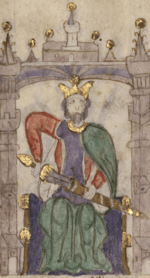Sancho II of Castile and León facts for kids
Quick facts for kids Sancho II |
|
|---|---|

Sancho II in the Castilian manuscript Compendium of Chronicles of Kings (...) (c. 1312-1325). Currently located at Biblioteca Nacional de España.
|
|
| King of Castile | |
| Reign | 1065–1072 |
| Predecessor | Ferdinand I |
| Successor | Alfonso VI |
| King of León | |
| Reign | 1072 |
| Coronation | 12 January 1072 (León) |
| Predecessor | Alfonso VI |
| Successor | Alfonso VI |
| King of Galicia | |
| Reign | 1071–1072 |
| Predecessor | García II |
| Successor | Alfonso VI |
| Born | c. 1036/1038 Zamora |
| Died | 6 October 1072 (aged 33–36) Zamora |
| Burial | San Salvador de Oña |
| Consort | Alberta |
| Dynasty | Jiménez |
| Father | Ferdinand I of León and Castile |
| Mother | Sancha of León |
| Religion | Roman Catholicism |
Sancho II (born around 1036-1038, died October 7, 1072) was a powerful king in medieval Spain. He was known as Sancho the Strong (el Fuerte). He ruled as King of Castile from 1065 to 1072. Later, he also became King of Galicia (1071–1072) and León (1072).
Contents
Sancho's Family and Early Life
Sancho was born in Zamora. He was the oldest son of Ferdinand the Great and Sancha of León. Sancho was married to a woman named Alberta. We know her name because she is mentioned as Sancho's wife in old documents. Some historians thought she might have been a daughter of William the Conqueror, the King of England. However, later records suggest that William's daughter was actually engaged to Sancho's brother, Alfonso VI.
Sancho's father, Ferdinand the Great, was a very powerful ruler. He defeated his wife's brother in battle. After this victory, Ferdinand was crowned King of León and Castile. He called himself Imperator totius Hispaniae, which means "Emperor of all Spain."
When Ferdinand died in 1065, his kingdom was divided among his children. Sancho became King of Castile. His younger brother, Alfonso, became King of León. Their youngest brother, García, became king of the newly reestablished Kingdom of Galicia.
Each brother also received payments from the smaller Muslim states nearby, called Taifas. These payments were called parias. Sancho was supposed to get parias from the Taifa of Zaragoza. Ferdinand also gave some cities to his two daughters. Urraca received the city of Zamora. Elvira received the city of Toro. Both of these cities were located inside Alfonso's Kingdom of León.

Sancho's Reign and Conflicts
In 1068, Sancho fought against his cousins, Sancho IV of Navarre and Sancho of Aragon. This war was called the War of the Three Sanchos. Sancho won, and his Kingdom of Castile grew. He took back lands like Bureba, Alta Rioja, and Álava. These lands had been given to Sancho IV's father by Ferdinand I.
In the same year, Alfonso, Sancho's brother, attacked the Taifa of Badajoz. This was a state that paid tribute to their brother García. Sancho was worried that Alfonso wanted to conquer his brothers' lands. So, Sancho defeated Alfonso in the Battle of Llantada. This battle helped to restore things to how they were before.
However, Sancho soon wanted more land for himself. In 1071, he teamed up with Alfonso. They marched across León to conquer García's northern lands. At the same time, Alfonso was in the southern part of García's kingdom. García had to flee and went to live in the Taifa of Seville. Sancho and Alfonso then divided the Kingdom of Galicia between them.
Sancho Takes More Kingdoms
Sancho soon turned against Alfonso. In 1072, with the help of his military leader, El Cid, Sancho defeated Alfonso. This happened at the Battle of Golpejera. Alfonso had to flee and went to live in the Taifa of Toledo.
On January 12, 1072, Sancho was crowned King of León. This meant he now held all three crowns that his father Ferdinand had given to his sons just six years earlier. Sancho's sister Elvira's city of Toro fell easily to him in 1072. But his other sister Urraca's city of Zamora was much stronger. Sancho's army got stuck trying to conquer Zamora.
Sancho's Death
During the siege of Zamora, a noble from Zamora named Vellido Adolfo (also known as Bellido Dolfos) entered Sancho's camp. He pretended to be a soldier who had left Zamora. But instead, he assassinated King Sancho. El Cid chased Vellido back to Zamora. Vellido escaped into the city through a gate now called Portillo del Traidor, which means "Gateway of the Traitor."
After Sancho's death, his brother Alfonso, whom Sancho had previously removed from power, became king of all his kingdoms. García, their youngest brother, was tricked by Alfonso into returning from exile. Alfonso then imprisoned García for life. This left Alfonso in complete control of all the lands their father had ruled. Alfonso later took on his father's title, "Emperor of all Spain." Sancho was buried in San Salvador de Oña.
|
Sancho II of Castile and León
House of Jiménez
Born: circa 1036/38 Died: 7 October 1072 |
||
| Regnal titles | ||
|---|---|---|
| Preceded by Ferdinand I |
King of Castile 1065–1072 |
Succeeded by Alfonso VI |
| Preceded by García II |
King of Galicia 1071–1072 with Alfonso VI |
|
| Preceded by Alfonso VI |
King of León 1072 |
|
See also
 In Spanish: Sancho II de Castilla para niños
In Spanish: Sancho II de Castilla para niños

